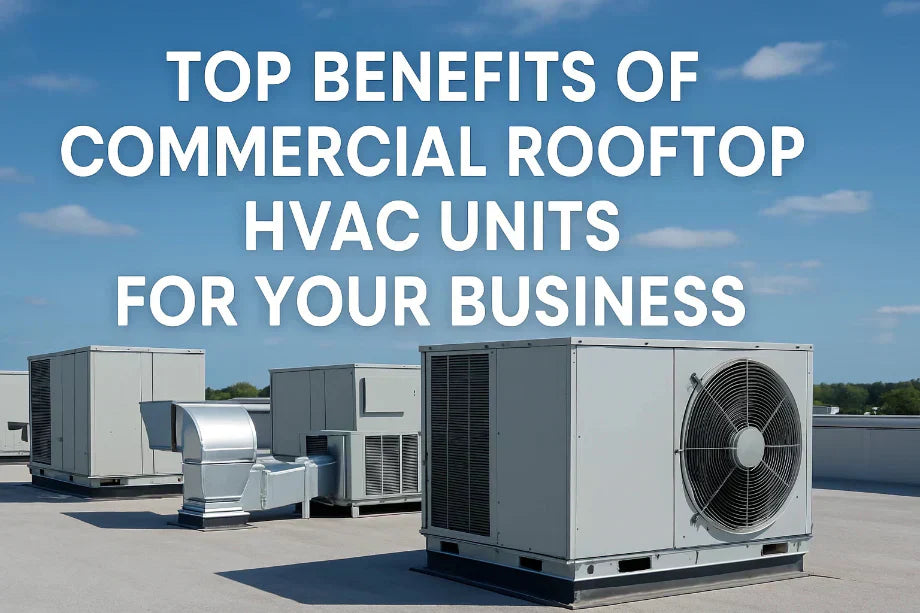👋 Hey there, business owner—Mark here!
After two decades installing and servicing HVAC systems in all kinds of commercial spaces, I can tell you this: commercial rooftop HVAC units are a powerhouse solution for many businesses. They save valuable indoor real estate, centralize equipment for easier upkeep, and deliver the kind of cooling and heating power large spaces demand.
If you’re wondering whether a rooftop package unit is right for your business—or even your home’s upper floor—you’re in the right place. I’ll explain the basics, give tips on sizing and efficiency, and help you understand why 460-volt, 3-phase units are industry favorites.
🏗️ What Are Commercial Rooftop HVAC Units?
At their core, commercial rooftop HVAC units (sometimes called RTUs or rooftop package units) are self-contained heating and cooling systems mounted on the roof of a building. They combine compressors, fans, coils, and controls into a single weatherproof enclosure. These units handle everything from air conditioning and heating to ventilation and sometimes even air filtration.
Because they’re mounted outside, they free up indoor space for offices, retail, or storage—and keep noisy compressors and fans out of earshot. Plus, roof installation simplifies ductwork by delivering conditioned air straight down through the ceiling.
For businesses that need dependable climate control with minimal footprint, rooftop HVAC units are a smart bet.
⚙️ Why Choose a Rooftop AC Package Unit 460 3 Phase?
Large commercial buildings often rely on 460-volt 3-phase power because it efficiently handles heavy electrical loads. Rooftop AC package units built for 460V 3-phase power can support higher capacities and maintain reliability even under constant demand.
This balanced energy flow reduces electrical issues and enhances system stability, leading to fewer breakdowns and less downtime—critical for any business operation.
For a broader look at how energy efficiency is evolving in both residential and commercial buildings—including the benefits of advanced electrical systems like 3-phase power—the U.S. Department of Energy shares insightful trends and data in their Energy Efficiency Trends report.
🌟 Best Residential Rooftop HVAC Units: Are They a Thing?
Though rooftop HVAC units are primarily designed for commercial use, smaller versions are increasingly popular for residential applications, especially in multi-family buildings or larger homes that want to save indoor space.
Residential rooftop units typically have lower capacities—usually under 5 tons—and often support smart thermostat integration for zoning and energy management. Brands like Goodman, Trane, and Rheem offer these packaged systems tailored to residential needs.
For homeowners interested in energy-efficient cooling solutions, the U.S. Department of Energy provides detailed guidance on selecting and maintaining air conditioners and heat pumps that help maximize comfort while minimizing energy costs. You can find their practical advice and energy-saving tips for home cooling systems here.
This resource is a great place to start when exploring options like rooftop HVAC units or other residential cooling technologies.
🛠️ Key Features to Look For in Commercial Rooftop Units
When you're evaluating commercial rooftop HVAC units, there are a few key features that separate a dependable system from one that’s just... adequate.
-
Energy Efficiency: Look for units with high SEER2 ratings and compatibility with energy-saving programs—these can significantly cut long-term operating costs and may qualify for rebates.
-
Durability: Your rooftop unit needs to withstand the elements. Models with rust-resistant coatings and reinforced housings are better equipped to handle harsh weather.
-
Smart Controls: Integration with building management systems (BMS) allows for real-time monitoring, scheduling, and fault detection, helping reduce unnecessary service calls.
-
Variable-Speed Technology: Compressors and fans that adjust based on demand provide more consistent comfort and use less energy.
-
Maintenance Accessibility: Easy-access panels and modular parts make routine service faster, reducing downtime and labor costs.
To help you keep your rooftop system running at peak performance, the U.S. Department of Energy offers a detailed resource on preventative maintenance for commercial HVAC equipment. It outlines how proper upkeep can improve reliability and efficiency while saving up to 20% annually in energy costs—essential reading for any facility manager or business owner investing in rooftop systems.
📐 How to Size Commercial Rooftop HVAC Units Properly
Proper sizing is essential. Oversized units cycle on and off too frequently, wasting energy and shortening equipment life. Undersized units struggle to maintain comfort and wear out faster.
A thorough load calculation considers:
-
Building square footage
-
Insulation and window quality
-
Occupancy and usage patterns
-
Equipment and lighting heat gain
-
Local climate conditions
Professional HVAC contractors use Manual J and Manual D calculations to determine the right size. For those wanting to understand the basics, the American Society of Heating, Refrigerating and Air-Conditioning Engineers (ASHRAE) provides standards and best practices you can review here.
🔧 Installation Tips and Considerations
Rooftop HVAC installations require:
-
Proper roof structural assessment to support unit weight
-
Electrical service matched to unit requirements (e.g., 460V 3-phase)
-
Weatherproof sealing and vibration isolation
-
Compliance with local codes and permits
An experienced HVAC pro will ensure proper duct connections and drainage to prevent leaks and mold growth.
🔌 Mark’s Plug & Play Recap
When it comes to keeping your building comfortable and efficient, commercial rooftop HVAC units are tough to beat. They save valuable floor space, handle large loads with ease, and are built to stand up to the demands of commercial environments—especially when you’re working with 460V 3-phase power.
And if you’re thinking about rooftop units for a residential setup, there are compact options out there that can still deliver serious performance. Just make sure you’re prioritizing long-term efficiency and easy maintenance from day one.
Looking to take the next step in upgrading your home or small business with smarter cooling? I’ve got you covered—check out my full breakdown on 🌍 The Complete Guide to a 2.5 Ton Air Conditioner: Smart Cooling for Smart Homes for everything you need to know.
Stay cool, stay smart—
– Mark







